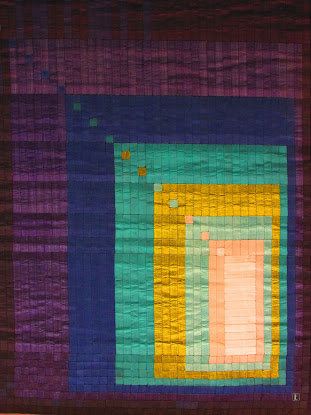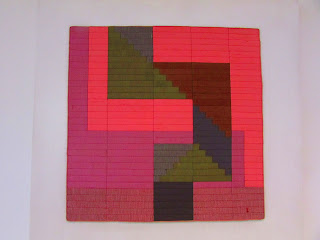Lucienne Day - Black Window, (detail)
"I do regard them rather like my children... I love to hear how they're getting on." - Lucienne Day 1994.
Clothing and lifestyle store Margaret Howell on Wigmore Street, Marylebone, made for a really welcome change of venue to the usual museums and galleries I frequent in search of inspirational exhibitions of art and design. On this occasion it was to see the dazzling colours and geometric textile constructions which make up the silk mosaics displayed here by legendary textile designer Lucienne Day (1917-2010). Lucienne Day was married to the equally talented furniture and industrial designer Robin Day. Lucienne Day first made her presence felt at the Festival of Britain exhibition in 1951, winning praise for her strikingly modern printed textile designs on furnishing fabrics for retailers such as Heal's. These designs were pioneering in a period of post-war gloom. Day's designs combined abstracted plant forms with geometric motifs to create forward-looking fabrics which are still influential today in the works of contemporary artists and designers such as Angie Lewin. Day's surface pattern designs were also applied to other surfaces including ceramics, wallpapers and carpets.
Lucienne Day - Calyx, 1951
There was a gradual decline in textile manufacturing in the 1970s and finding a new outlet for her talents Day began to create one-off textile wall hangings which use the basic techniques of construction as patchworks quilts, which are basically strips of fabric stitched together to create patterned cloths. Day consciously chose to dissociate her work with the centuries old tradition of quilting for whatever reason despite the obvious similarities, instead choosing to title her creations as silk mosaics. The term Silk Mosaic was coined because the individual units of the patched pieces were so small that they recalled the tesserae in Roman mosaics. This allusion was particularly apt because the vivid colouring of the glass tesserae were mirrored in the richly-coloured dyed silks of Day's Silk Mosaics. Although Day created the designs, she did not sew them herself, rather she outsourced their hand-crafted construction to talented seamstresses. Day also selected the silk fabrics herself, choosing the colours and textures of the fabric to purposely exploit the slubby yarns and two-tone iridescence of shot silks (woven from different coloured warp and weft) adding further levels of depth to her designs. The fabrics in the designs have held their colour well over the years, and as mentioned earlier they really do sing and appear to shine like stained glass or jewels. I find that I prefer the less literal, more abstract designs of Day's silk mosaics. The more representational pieces look a little too twee for my tastes. The technique seems to work better with Day's abstract geometric designs. I found that there were certain similarities with the work of another textile designer, the great Anni Albers, in Day's silk mosaics, and there was even one piece here which shared the same title, Meander, as my favourite textile design by Albers. This was my first introduction to this aspect of Lucienne Day's work and I found these works to be every bit as engaging as her printed textile designs of the 1950s. I shall be certainly seeking out further examples of these gorgeous geometric gems.
The Castle and Other Stories - 1979
White Door, Mid 1970s
Black Window, Mid 1970s
Mexico - ca. early 1980s
Little Tangram (Pink), 1983
Little Tangram (Pink), 1983
Museum II, 1990
Purple Shadow, 1990
Meander 1, 1980s
Tangram 3, 1985
Memory Game, 1993
Circling the Square 3, 1981
Circling the Square 2, 1981
Midnight Sun, Mid 1980s
Three Daughters of Mexico, 1992
Patchwork Quilt, 1954
Causeway, 1967
Whirligig, 1979
Whirligig, 1979
Boathouse, 1983
Boathouse, 1983
Lucienne Day Silk Mosaics 1975-1993
until Sunday 3rd November
Margaret Howell
34 Wigmore Street
London W1










































No comments:
Post a Comment